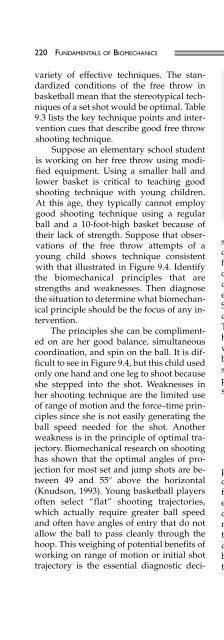Fundamentals of Biomechanics
Fundamentals of Biomechanics
Fundamentals of Biomechanics
You also want an ePaper? Increase the reach of your titles
YUMPU automatically turns print PDFs into web optimized ePapers that Google loves.
220 FUNDAMENTALS OF BIOMECHANICS<br />
variety <strong>of</strong> effective techniques. The standardized<br />
conditions <strong>of</strong> the free throw in<br />
basketball mean that the stereotypical techniques<br />
<strong>of</strong> a set shot would be optimal. Table<br />
9.3 lists the key technique points and intervention<br />
cues that describe good free throw<br />
shooting technique.<br />
Suppose an elementary school student<br />
is working on her free throw using modified<br />
equipment. Using a smaller ball and<br />
lower basket is critical to teaching good<br />
shooting technique with young children.<br />
At this age, they typically cannot employ<br />
good shooting technique using a regular<br />
ball and a 10-foot-high basket because <strong>of</strong><br />
their lack <strong>of</strong> strength. Suppose that observations<br />
<strong>of</strong> the free throw attempts <strong>of</strong> a<br />
young child shows technique consistent<br />
with that illustrated in Figure 9.4. Identify<br />
the biomechanical principles that are<br />
strengths and weaknesses. Then diagnose<br />
the situation to determine what biomechanical<br />
principle should be the focus <strong>of</strong> any intervention.<br />
The principles she can be complimented<br />
on are her good balance, simultaneous<br />
coordination, and spin on the ball. It is difficult<br />
to see in Figure 9.4, but this child used<br />
only one hand and one leg to shoot because<br />
she stepped into the shot. Weaknesses in<br />
her shooting technique are the limited use<br />
<strong>of</strong> range <strong>of</strong> motion and the force–time principles<br />
since she is not easily generating the<br />
ball speed needed for the shot. Another<br />
weakness is in the principle <strong>of</strong> optimal trajectory.<br />
Biomechanical research on shooting<br />
has shown that the optimal angles <strong>of</strong> projection<br />
for most set and jump shots are between<br />
49 and 55º above the horizontal<br />
(Knudson, 1993). Young basketball players<br />
<strong>of</strong>ten select “flat” shooting trajectories,<br />
which actually require greater ball speed<br />
and <strong>of</strong>ten have angles <strong>of</strong> entry that do not<br />
allow the ball to pass cleanly through the<br />
hoop. This weighing <strong>of</strong> potential benefits <strong>of</strong><br />
working on range <strong>of</strong> motion or initial shot<br />
trajectory is the essential diagnostic deci-<br />
Table 9.3<br />
CRITICAL FEATURES AND TEACHING<br />
CUES FOR THE FREE THROW<br />
Critical Possible teaching/<br />
feature intervention cues<br />
Staggered stance Shooting side foot forward<br />
Shooting plane Align your arm with the basket<br />
Height <strong>of</strong> release Release high above your head<br />
Coordination Extend your whole body<br />
Angle <strong>of</strong> release Shoot with high arc<br />
Ball rotation Flip your wrist<br />
sion in this case. There are several biomechanical<br />
reasons why it is likely more beneficial<br />
to work on shot trajectory than increasing<br />
range <strong>of</strong> motion. First, using the<br />
desirable trajectory increases the angle <strong>of</strong><br />
entry and the probability <strong>of</strong> a made shot.<br />
Second, this slightly higher trajectory requires<br />
less ball speed than a very flat one.<br />
Third, the young player is likely to increase<br />
her strength while the desirable trajectory<br />
will remain the same. The interaction <strong>of</strong><br />
biomechanics and performer characteristics<br />
suggests to the teacher that subsequent<br />
practice should focus on a slightly higher<br />
shot trajectory.<br />
EXERCISE/ACTIVITY<br />
PRESCRIPTION<br />
Another important content area <strong>of</strong><br />
physical education is fitness. Physical educators<br />
planning to increase student physical<br />
fitness must employ biomechanical knowledge<br />
to determine the most effective exercises<br />
for various parts <strong>of</strong> the body and fitness<br />
components. Like strength and conditioning<br />
pr<strong>of</strong>essionals, physical educators<br />
qualitatively analyze exercise technique to<br />
be sure that students are safely training<br />
their bodies.






